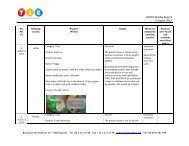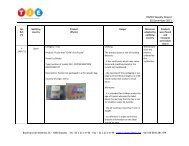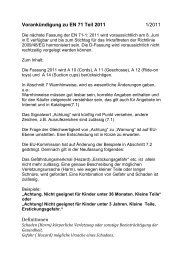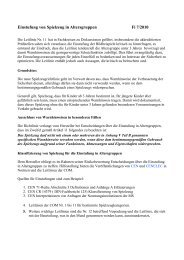You also want an ePaper? Increase the reach of your titles
YUMPU automatically turns print PDFs into web optimized ePapers that Google loves.
<strong>EN</strong> <strong>71</strong>-1:<strong>2005+</strong><strong>A8</strong>:2009 (E)<br />
Key<br />
1 Test load, 25 kg, with articulated arm<br />
2 Dynamometer<br />
3 Test load, 20 kg<br />
4 Platform and stabilizers with a height of 250 mm and a mass of (4,8 ± 0,2) kg.<br />
64<br />
-Figure 25. – Brake performance for toy scooters with foot brake<br />
8.27 Strength of toy scooter steering tubes (see 4.15.5.3)<br />
8.27.1 Resistance to downward forces<br />
Place the toy scooter on a horizontal plane and secure it so that it will stand upright during the test. Check that<br />
the locking devices are correctly engaged.<br />
a) For toy scooters with two handles, suspend a mass of (50 ± 0,5) kg at the centre of each handle -(see<br />
Figure 26 a)).. Maintain the load for 5 min.<br />
Determine whether the steering tube collapses and the locking devices are still operable and engaged.<br />
Remove the 50 kg masses. Release the main locking device and with the secondary locking device still<br />
engaged, load the handles with a mass of (25 ± 0,2) kg each and maintain the load for 5 min.<br />
Determine whether the secondary locking device is still operable and engaged.<br />
NOTE If it is not evident which locking device is the main locking device, each locking device should be tested<br />
under the assumption that it is the main locking device.<br />
b) For toy scooters with steering tubes without handles, perform the test as in a) above using a load with a<br />
mass of (100 ± 1) kg and (50 ± 0,5) kg respectively on top of the tube -(see Figure 26 b))..








